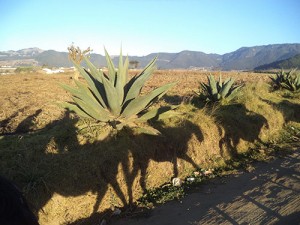Trip Report: Alternative Winter Break in Guatemala
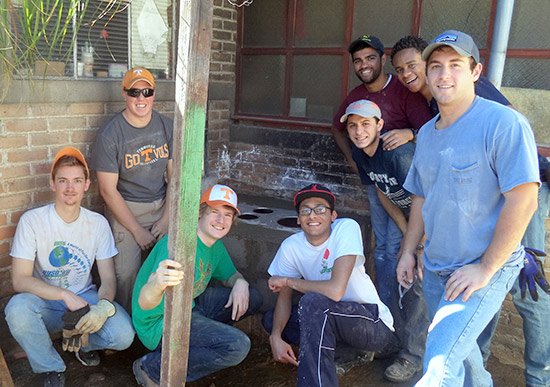
- Read Chirag Tailor’s report on the trip »
- Read Tyler Leek’s report on the trip »
- Read Neel Patel’s report on the trip »
- Read Luke Weber’s report on the trip »
- Read Evan Wilmer’s report on the trip »
- Read David Michalik’s report on the trip »
The Tickle College of Engineering sponsored an Alternative Winter Break to the city of Quetzaltenango, located in the southwestern part of Guatemala, between December 14 and 21 of 2014. Attending the trip were Chirag Tailor, senior electrical engineering and computer science major; Luke Weber and Tyler Leek, both senior chemical engineering majors; Neel Patel and David Michalik, both senior mechanical engineering majors; Logan McNeil, senior biomedical engineering major; Evan Wilmer, freshman chemical engineering major; and Paul Barry, senior animal science major. Judith Mallory, TCE International Coordinator, led the trip, coordinated by Utopia Volunteers, Traverse City, Michigan.
Approximately the same size as Tennessee, Guatemala contains the intersection of three tectonic plates. It has about twelve million people and the highest gross domestic product of the region, yet the highest rates for illiteracy and infant mortality in Central America. There are two distinct ethnic groups, the “Ladinos,” or Mestizos, those descended from Spanish immigrants; and the indigenous Mayan descendants, of which there are many subgroups, each with their own dialect or language. Although Guatemala is officially Catholic, most of the country’s religion can be classified as syncretism, a mix of indigenous beliefs and customs and mainstream Catholicism.
The group flew into the Guatemala City Airport and boarded a van for the four-hour journey west to Quetzaltenango, the country’s second-largest city. The van’s Cuban driver, Rudy, gave his own impressions of a country that was foreign to him, as well. It was not uncommon to see people walking very closely to the highway, darting into traffic to cross the road, and sometimes fitting a family of four onto a single bicycle.
Pick-up trucks with as many as eighteen people standing in the truck bed were seen along the highway, as well as crowded “chicken buses,” which resemble a school bus with a luggage rack on top for transporting live poultry.
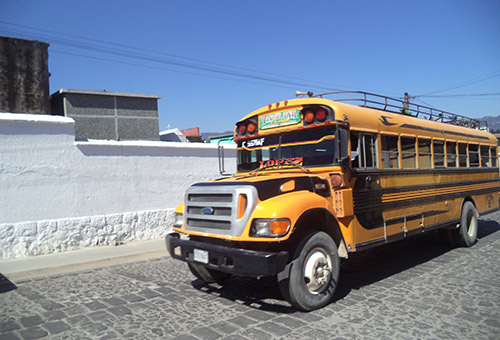
It was dark by the time the group made it to the homes of the two families with whom they would be staying. The first stop was at Don Hugo’s home to drop off one-half of the group, then several blocks away to Don Francisco’s to drop off the rest. Typical Guatemalan homes are walled from the street and have one or more open “courtyard” spaces inside, sometimes used as a carport area, sometimes planted, decorated, and used for lounging. The surrounding house area is open to this courtyard area and exposed to the elements.
Temperatures in the day sometimes reached around 80 degrees, while at night were around 40 degrees Fahrenheit. The houses are not insulated nor are they heated. Don Hugo’s wife is a language instructor, thus has decent English skills. In contrast, little or no English was spoken by members of Don Francisco’s family. Both families provided filtered water for drinking, as the water in Guatemala is known to contain parasites.
Each morning after breakfast, the group met at the home of Don Hugo to be transported to the worksites, which varied each day. Specifically, the group was charged with constructing safe cook stoves for six indigenous families. The traditional and ancient cooking method of the Amerindian descendants of the Maya involves cooking on the floor on stones passed through the generations. Cooking takes place in a non-vented area, filling the living area with smoke and fumes. This practice has led to widespread lung disease throughout Guatemala. Understandably, it is also dangerous for children who could be passing the cooking area and fall in. The solution is a safe cook stove, vented to the outdoors, much as one would do with a clothes dryer. The new stove is more efficient than open-floor cooking, contains the fire, and uses less wood. This is an environmental bonus, as Guatemala suffers from deforestation.
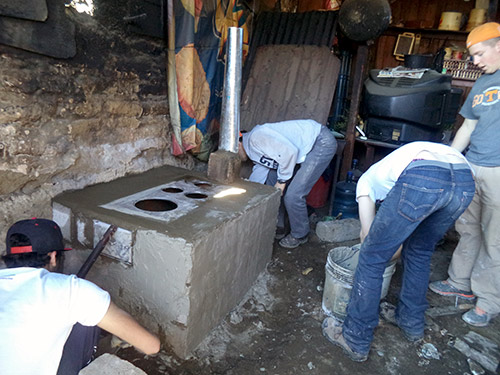
Construction of each stove began with the leveling out of the dirt floor upon which the stove was to be built. Standard concrete cinder blocks were used to construct three sides of the stove, with an existing wall serving as the fourth side of the rectangular-shaped stove. The blocks were left empty, allowing air to serve as an insulator. Concrete was mixed on the floor for use in mortaring the blocks in place. Cinder blocks were cut with the use of a machete. Several rows of the blocks were stacked, resulting in a structure a bit more than knee-high. A small metal door was installed on the front side of the stove, to add wood and remove ashes.
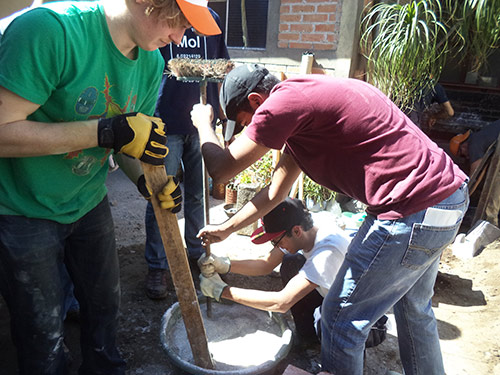
About two-thirds of the interior of the stove was then filled with local soil, which happens to be volcanic and will also aid in heat-retention. Terracotta blocks approximately 6″ x 4″ x 2″ were then placed on top of the fill-dirt to create a smooth area for the wood. Finally, a piece of sheet steel the same dimensions of the top of the stove was put in place, and mortared-in. The top has the venting hose attached. A stove must settle and the concrete fully cure before the vent hose can be placed through the roof, and the stove used. The stove should be fully functioning about two weeks after installation.
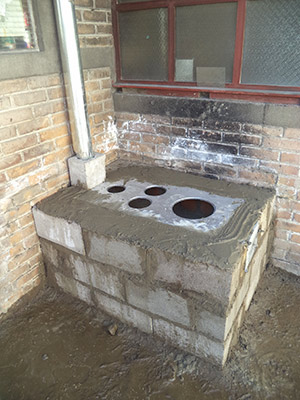
Tools were what one might expect in a developing nation; they were inadequate in supply and broke during the first day of use, so a trip to the hardware store was in order for replacements. A local foreman led the construction of the stoves, and each recipient was delighted to have theirs built. The typical home place in the somewhat rural area in which we worked consisted of an entrance walled from the street—in fact, no “homes” were visible from the cobblestone street.
Inside, there were usually several “rooms,” not always connected, often with areas in between open to the outside. Some homes had rustic ladders attached to the walls for second-floor access. Where a roof exists, it is usually constructed of corrugated tin. All of the homes had an outdoor “pila,” or three-sectioned sink, typical in Latin America. The water in the center section of the pila is to stay clean—no exceptions. Water may be dipped from this section to either side, where one may wash vegetables, hands, or even clothing. All three sections drain directly to the ground. Some of the home sites grew vegetables and flowers, others had poultry and rabbits.
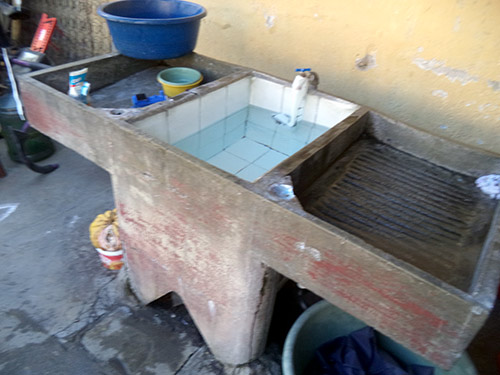
The “city” houses, also walled from the street, are faced with sidewalks about 14 inches high off of the street, and only about 18 inches wide. The pilas were found inside of the city houses, in contrast to being outdoors in the more rural homes. Many of these residents owned dogs, all of which are kept on the flat roofs of the houses, with no fence or railing. The sound of dogs barking was common and nearly constant.
Side activities included a visit to the town square, horseback riding in the country, and a visit to Las Calientes Georginas, a volcanic hot spring at 8,000-foot elevation. The group also took a short trip over to the Pacific Coastal town of Tulate, about three and a half hours away from Quetzaltenango.
